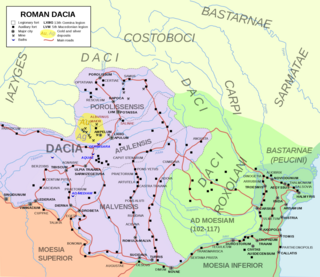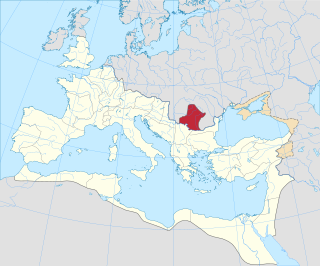Dacia , or Kingdom of Dacians, is an ancient geographic demarcation of Central and Southeastern Europe.
Contents
Dacia may also refer to:
Dacia , or Kingdom of Dacians, is an ancient geographic demarcation of Central and Southeastern Europe.
Dacia may also refer to:

Dacia was the land inhabited by the Dacians, its core in Transylvania, stretching to the Danube in the south, the Black Sea in the east, and the Tisza in the west. The Carpathian Mountains were located in the middle of Dacia. It thus roughly corresponds to present-day Romania, as well as parts of Moldova, Bulgaria, Serbia, Hungary, Slovakia, and Ukraine.

Moesia was an ancient region and later Roman province situated in the Balkans south of the Danube River. Moesian Province was first administered by governor of Noricum as 'Civitates of Moesia and Triballia'. It included most of the territory of modern eastern Serbia, Kosovo, north-eastern Albania, northern parts of North Macedonia, Northern Bulgaria, Romanian Dobruja and small parts of Southern Ukraine.

S.C. Automobile Dacia S.A., commonly known as Dacia, is a Romanian car manufacturer that takes its name from the historical region that constitutes present-day Romania. The company was established in 1966. In 1999, after 33 years, the Romanian government sold Dacia to the French car manufacturer Groupe Renault. It is Romania's largest company by revenue and the largest exporter, constituting 8% of the country's total exports in 2018. In 2021, the Dacia marque sold 537,074 passenger and commercial vehicles.

Romanians are a Romance-speaking ethnic group and nation native to Central, Eastern and Southeastern Europe. Sharing a common culture and ancestry, they speak the Romanian language and live primarily in Romania and Moldova. The 2021 Romanian census found that 89.3% of Romania's citizens identified themselves as ethnic Romanians.

Satu Mare is a city with a population of 102,400 (2011). It is the capital of Satu Mare County, Romania, as well as the centre of the Satu Mare metropolitan area. It lies in the region of Maramureș, broadly part of Transylvania. Mentioned in the Gesta Hungarorum as castrum Zotmar, the city has a history going back to the Middle Ages. Today, it is an academic, cultural, industrial, and business centre in the Nord-Vest development region.
Dacian, Geto-Dacian, Daco-Getic or Daco-Getian often refers to something of or relating to:
Romula or Malva was an ancient city in Roman Dacia, later the village of Reşca, Dobrosloveni Commune, Olt County, Romania. It was the capital of Dacia Malvensis, one of the three subdivisions of the province of Dacia.
The term Daco-Roman describes the Romanized culture of Dacia under the rule of the Roman Empire.

Dacia Aureliana was a province in the eastern half of the Roman Empire established by Roman Emperor Aurelian in the territory of former Moesia Superior after his evacuation of Dacia Traiana beyond the Danube in 271. Between 271/275 and 285, it occupied most of what is today northwestern Bulgaria and eastern Serbia. Its capital was in Serdica.

The Dacia 1300 is a medium-sized family car based on the Renault 12 that was built during the Cold War by Romanian auto maker Dacia. The "1300" stands for the engine displacement. The first Dacia 1300 left the assembly line on 23 August 1969. On 21 July 2004, the last Dacia 1310, number 1,959,730, rolled out the gates of the Mioveni production facility, just one month before its 35th anniversary.

Clubul Sportiv Mioveni, commonly known as CS Mioveni or simply Mioveni, is a Romanian professional football club based in Mioveni, Argeș County, that competes in the Liga II.

Ratiaria was a city founded by the Moesians, a Daco-Thracian tribe, in the 4th century BC, along the river Danube. In Roman times it was named Colonia Ulpia Traiana Ratiaria.

Located in Roman province of Dacia, present-day Romania, the Limes Porolissensis was a frontier of the Roman empire in Dacia Porolissensis, the northernmost of the three Dacian provinces. It was a defensive line dating from the 2nd century AD after the Conquest of Dacia. The frontier was a complex network of over 100 observation towers, fortlets, walls and forts disposed in a line over 200 km from the Apuseni Mountains to the Eastern Carpathians, following the highland chain of the Meseș Mountains.

Cumidava was originally a Dacian settlement, and later a Roman military camp on the site of the modern city of Râșnov in Romania.

The appearance of Celts in Western Romania can be traced to the later La Tène period . Excavation of the great La Tène necropolis at Apahida, Cluj County, by S. Kovacs at the turn of the 20th century revealed the first evidence of Celtic culture in Romania. The 3rd–2nd century BC site is remarkable for its cremation burials and chiefly wheel-made funeral vessels.

Tibiscum was a Dacian town mentioned by Ptolemy, later a Roman fort and municipium. The ruins of the ancient settlement are located in Jupa, near Caransebeș, Caraș-Severin County, Romania. The Roman settlement here was one of the most important vestiges of classical antiquity in Banat.

The castra of Hoghiz was a fort in the Roman province of Dacia. The fort was built in the 2nd century AD, on the left bank of the Olt River, at a place where a Dacian settlement existing already in the 2nd century BC was unearthed. The fort and the nearby village were abandoned in the 3rd century AD. The ruins of the castra are located in Hoghiz, Romania.

Roman Dacia was a province of the Roman Empire from 106 to 271–275 AD. Its territory consisted of what are now the regions of Oltenia, Transylvania and Banat. During Roman rule, it was organized as an imperial province on the borders of the empire. It is estimated that the population of Roman Dacia ranged from 650,000 to 1,200,000. It was conquered by Trajan (98–117) after two campaigns that devastated the Dacian Kingdom of Decebalus. However, the Romans did not occupy its entirety; Crișana, Maramureș, and most of Moldavia remained under the Free Dacians.